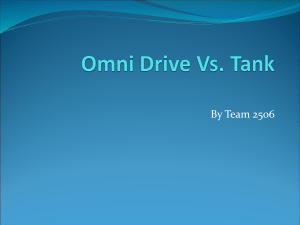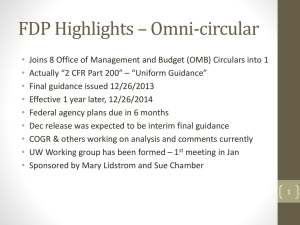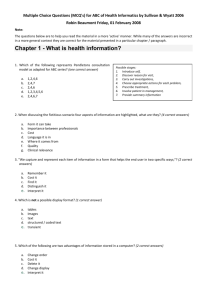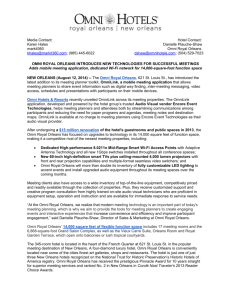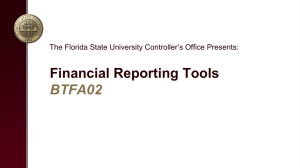A Consumer-focused Account Promotion Strategy for Branchless
advertisement
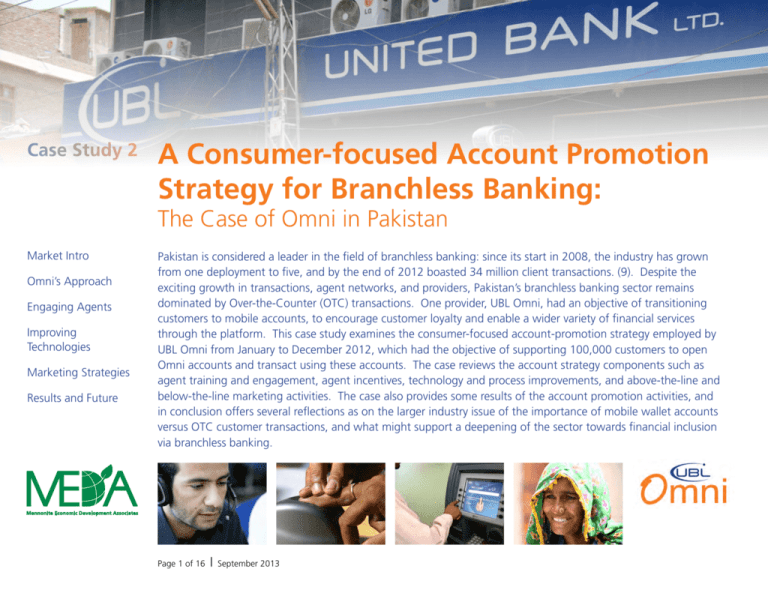
Case Study 2 A Consumer-focused Account Promotion Strategy for Branchless Banking: The Case of Omni in Pakistan Market Intro Omni’s Approach Engaging Agents Improving Technologies Marketing Strategies Results and Future Pakistan is considered a leader in the field of branchless banking: since its start in 2008, the industry has grown from one deployment to five, and by the end of 2012 boasted 34 million client transactions. (9). Despite the exciting growth in transactions, agent networks, and providers, Pakistan’s branchless banking sector remains dominated by Over-the-Counter (OTC) transactions. One provider, UBL Omni, had an objective of transitioning customers to mobile accounts, to encourage customer loyalty and enable a wider variety of financial services through the platform. This case study examines the consumer-focused account-promotion strategy employed by UBL Omni from January to December 2012, which had the objective of supporting 100,000 customers to open Omni accounts and transact using these accounts. The case reviews the account strategy components such as agent training and engagement, agent incentives, technology and process improvements, and above-the-line and below-the-line marketing activities. The case also provides some results of the account promotion activities, and in conclusion offers several reflections as on the larger industry issue of the importance of mobile wallet accounts versus OTC customer transactions, and what might support a deepening of the sector towards financial inclusion via branchless banking. Page 1 of 16 | September 2013 Introduction The Pakistan Branchless Banking Market in Brief Pakistan is considered a leader in the field of branchless banking: since its start in 2008, the industry has grown from one deployment to five, and boasted 34 million client transactions in the last quarter of 2012. (9). Supportive regulation from the State Bank of Pakistan, as well as government focus on cash transfer programs to incentivize providers to enter the market have been credited with the growth of the sector. Market Intro Omni’s Approach Engaging Agents Improving Technologies Marketing Strategies Results and Future Over-the-counter (OTC) transaction—A mobile money transaction where the customer does not have an account, but simply hands over cash to an agent who facilitates the transaction on the customer’s behalf using their own mobile money account. (1) Despite the exciting growth in transactions, agent networks, and providers, Pakistan’s branchless banking sector remains dominated by Over-the-Counter (OTC) transactions. This means that the transaction must be facilitated by an agent, rather than by the customer on their own using their mobile phone. While OTC transactions were a very good entry level product for branchless banking, UBL Omni, one of the banks operating a branchless banking business, had a long-term goal of supporting customers to move to accountbased transactions rather than only OTC. This could lower the costs of transactions for both Omni and the customer, since there would not be a need to interact with an agent for each transaction. Since an estimated 120 million people have a cell phone in Pakistan, and over 90% of people live in areas with cell phone coverage, mobile money(including account-based m-money) is a real market opportunity (CIA Factbook; 1). However, despite this high rate of access to cell phones, the rates of m-money usage and account registration are low – only about 5% of Pakistani households use mobile money, and only about 0.3% of households have a registered m-money account (1). The way that branchless banking developed over the past several years in Pakistan –with a focus on bill payments and other one-off transactions—meant that as of 2011 OTC transactions were the dominant type of product. This familiarity with OTC transactions had the disadvantage that neither customers nor agents saw the incentive of branchless accounts. Clients found OTC transactions (primarily money transfer and bill payments) easy and fast; agents assumed that transitioning customers to accounts would decrease their earnings since it would remove the need for customers to visit the Duukan. There was a need to convince both groups about the advantages of account-based branchless banking. This was Omni’s goal in their new account promotion strategy. uu References | Acknowledgments Page 2 of 16 | September 2013 omni Omni’s Approach: Promoting Level Zero Branchless Banking Accounts Market Intro Omni’s Approach Engaging Agents Improving Technologies Marketing Strategies Omni felt that it would be more beneficial to transition customers, especially better-performing customers, to branchless banking accounts. This could create higher customer loyalty, while expanding the number of services that Omni (or their partners) could potentially offer to the customer. It could also have the potential benefit of lowering the costs of servicing customers, who would then not need to enter an Omni Dukaan for each transaction. There are several reasons why industry experts often consider electronic accounts to be an improvement over OTC transactions, for example: Results and Future •Without an account, customers cannot store, access, or accumulate funds (no savings possible); •They also cannot be connected by direct deposit or automatic withdrawal to other institutions (e.g., employers, insurance providers) who might wish to offer additional financial services (2,1); •Customers without accounts do not build up any account-linked financial transactional history which could eventually be used to apply for loans or other financial products which require some proof of household income or cash flow. In prior years, there were also some regulatory issues that complicated account opening, fortunately these barriers were eased in 2011 when revised account levels, and corresponding know-your-client (KYC) were introduced by SBP. The new lower-limit “Level Zero” accounts had much simpler registration and KYC requirements, which would make it easier for Omni agents to promote and open accounts. This was one of the catalysts for Omni’s decision to move forward with the account opening strategy. The following sections examine the different components of the Omni account promotion strategy, including agent training and engagement activities and incentives, technology and process improvements, marketing activities, and the results of the promotional strategy after one year of implementation on account opening at Omni. uu References | Acknowledgments Page 3 of 16 | September 2013 Engaging Agents Training, recognition and incentives Market Intro Omni’s Approach Engaging Agents Improving Technologies Marketing Strategies Previous research and experimentation with different types of marketing approaches had convinced Omni that the agent network was the key to turning OTC clients into account-holders and users. For this reason agent engagement activities and incentives was a key component of the account eco-system development. The main objectives of the strategy component were to educate and motivate agents to become the primary proponents of account-opening and usage. Omni wanted to move towards a model where agents become the primary ambassador for Omni services, especially in customer education and trust-building around products. Results and Future Agent training and engagement activities To maximize the impact of the agent training and engagement, Omni identified a subset of the bestperforming agents, as well as mapped the highest priority locations of the country, to determine how many agents could be engaged with training sessions based on the project budget. The team wanted to be sure to cover the most high-traffic locations, including the top 50 cities and metro areas in Pakistan, with a goal of reaching about 60-80% of major urban, peri-urban, and rural hubs. The goal was to reach about 3,500 agents (out of a total of 7,000 active agents in December 2011) with agent training and engagement activities. The Omni Product Team created the training curriculum, with a focus on Omni business strategy as well as on how the engagement sessions could really work to help change the agent mindset around the benefits of OTC vs. account-based transactions. A ‘’Training of Trainers”(TOT) was conducted for area managers and zonal managers in December 2011 by three master trainers. Following the TOT, three agent engagements events were held in Karachi as test events (to capture agent feedback) before full roll out. Senior managers from Omni head office attended the events to share a message from management, and the events were also hosted by a local TV personality to generate media interest and a higher profile. Following these test events, the team realized the training needed to be made shorter and crisper, as the information as presented was too lengthy to maintain the attention of attendees. uu References | Acknowledgments Page 4 of 16 | September 2013 The training content included several components •An introductory section on the UBL Omni overall business, results to date, and importance of agents in the Omni business model; Market Intro Omni’s Approach Engaging Agents •Specific product information on new product features (Level Zero accounts), pricing slabs, and ATM cards (new product offering); Improving Technologies •Informative /instructional section on how to conduct specific transactions / troubleshooting of most common problems Results and Future Marketing Strategies •Motivation and incentives section, including a line-by-line breakdown on “How Omni helps you make more money” to illustrate the average revenue potential for agents that opened 150 accounts per month, including special commissions and lifetime commissions (explained further below) The presentation format included attractive power point slides with facilitation, interactive Q&A with agents, and videos. All materials were delivered in Urdu. Most agent engagement events were attended by approximately 100 agents, this number could be lower in less populated centers (for example Tier 2 or Tier 3 towns). At the time of the 2012 agent engagement, Omni had about 7,000 agents, of which 80% where considered active. Between December 2011 and February 2012 Omni successfully re-trained over 3,600 agents. In addition, Omni used this opportunity to recognize their best-performing agents with awards and give encouragement to the overall team. Agent feedback was positive, showing appreciation for a renewed focus on agent profitability, support, and recognition. Omni has also considered the agent engagement sessions as a valuable business tool, and repeated the sessions in 2013 using internal resources. In fact, the number of agents participating in the sessions increased by 65% in the second year to over 5,900 agents. Agent network team training and incentives The Omni Agent Network Team (consisting of Regional, and Area Managers and field staff i.e. Business Development Executives) recruits and manages the Omni Dukaan network of agents. To reach the agents with the account-opening strategy, Omni recognized that the network team would play an important role. Originally, the plan was to train network team staff, separately from the agents, however upon further discussion and testing it seemed more relevant to bring the BDEs and the agents together at the same time. This would save on costs, and also ensure that everyone heard the same information. BDEs could also hear the types of questions asked by agents, and have follow up conversations with their managers as needed. Incentives also remained in place to reward BDEs for accounts opened at agents they managed. During the agent engagement sessions, Omni also re-trained more than 500 Omni agent network staff. uu References | Acknowledgments Page 5 of 16 | September 2013 Agent incentives – proving the account value proposition for agents Because of the way that the branchless banking market has evolved in Pakistan, the market was and continues to be dominated by OTC transactions. Agents perceived that by opening accounts, this would decrease their earnings since customers would no longer need to enter the shop to transact, and no commission would be earned. To combat this perception, Omni needed to effectively design and communicate new benefits and incentives associated with the new accounts (Level Zero account), as well as emphasize the continuing importance of the agents to the Omni business model – even in an account-dominated market of the future. The pricing would need to reflect this easier transaction method, while at the same keeping agents’ motivated and earning revenue even from customers that begin to transact using their own account. Market Intro Omni’s Approach Engaging Agents Improving Technologies Marketing Strategies Results and Future These activities were also coordinated with ATL marketing campaigns (see below). The goal was to further generate interest among agents to promote accounts, by offering financial incentives. A revised agent incentive program was defined in December 2011, which included some of the following incentives: Transaction Type Incentive / Fee Paid Open new Level Zero account and activate the account 20 PKR Special Level Zero account opening “bonus” (offered only 30 PKR additional from Jun-Sept 2012) New account holder performs first account-based transaction Same fee paid as would have been earned as an OTC transaction Sale of new ATM card to account holder 20 PKR Sales of various monthly transaction packages for account holders. These packages provide discounts to customers who transact frequently. 85 PKR and up, depending on package ‘Lifetime commissions’ for agent that opened the account, when account owner transacts independently of agent 10% of fees generated from any account based transaction These incentives were carefully explained to agents in the training sessions, and then reiterated over time by agent network management team. Based on the revised incentive structure, Omni was able to successfully disburse a variety of account opening incentives to agents from January 2012-October 2012.In total, about 4,500 agents received commissions related to account opening and related services, and approximately $17,500 was paid through the revised incentives structures. These special incentives were offered for a limited time during the grant period as a push for account opening during that time. uu References | Acknowledgments Page 6 of 16 | September 2013 Improving Technologies: Agent-level upgrades to hardware and software Market Intro Omni’s Approach Engaging Agents Improving Technologies Marketing Strategies One of the drawbacks to account opening under the previous systems and account guidelines was the process itself: because of paperwork requirements, missing or incomplete information, or delays in various approvals from either UBL or SBP, Omni branchless banking accounts could take up to three weeks to be successfully opened and activated. In some cases up to 80% of accounts submitted were marked ‘discrepant’ for some reason or their forms were not received. However, the new Level Zero account guidelines provided an opportunity to review account-opening processes and related technologies to seek efficiencies and optimize the agent and customer experience around account-opening. Omni made several changes and investments in this regard: Results and Future •Simplified Level Zero information requirements: and the agent captures digital images of the customer’s CNIC and facial profile. They can then easily upload this request to Omni via internet/GPRS. •Improved CNIC image capture technology: agents were required to take photos of customers’ CNIC (national identification card), however in many cases(up to 80%) the photos were not legible and were rejected. Omni provided better training on how to capture improved images, and made upgraded versions of camera software available to agents for better image resolution. In some cases agents simply needed to configure camera settings differently on the phone to have improved image quality. In addition, in case of discrepancies or illegible copies/images, the customer is now able to update photo of CNIC at any agent location. •Hardware improvements: Omni’s approach to hardware has been to try and support the cheapest and most commonly available handsets and minimal PC requirements. The improvements to the solution and process were devised to ensure that commonly available mobile handsets and other hardware devices remain supported d no additional investment in this regard would need to be made by agents. •Scanners: Omni evaluated and piloted the use of low-cost scanners at agent locations for ID image capture, however the technology had issues with set up and usage. Instead Omni continued with an open platform approach having resolved webcam configuration, and stayed with webcam and mobile camera technologies as the optimal solution. uu References | Acknowledgments Page 7 of 16 | September 2013 •ATM cards: To make the accounts more attractive to customers, and to make Omni customers feel more like ‘real bank’ customers, Omni invested in an ATM card that would be attached to a branchless bank account. The ‘no-name’ ATM cards were procured from a local vendor at low cost and can be issued immediately at an agent location, without need for issuance / distribution by the bank, due to previously embossed account numbers which are then associated (by the agent) to the Level Zero (or level 1,2) branchless account. The cards can be used at any UBL ATM location to withdraw funds, at any other bank ATM in Pakistan to access funds, as well as at POS locations to do direct debit transactions, mainly in major urban cities and towns. Market Intro Omni’s Approach Engaging Agents Improving Technologies Marketing Strategies Results and Future •Expanded account opening locations: Omni ensured that accounts could be opened across the network (not only in select agent locations), and that account opening was possible from any agent device including PC or mobile handset. Following these process investments, Omni accounts are now opened much more quickly, in a paperless environment. All accounts are processed within 48 hours, and 85% are opened successfully in that time frame. The remaining accounts require updated images or other corrections. This improved processing time makes it much easier for an agent to encourage customers to open and use accounts in a short time frame. Additionally, revised regulations allow customers to complete one debit and one credit transaction from a new account, prior to account opening being completed by the bank (i.e. immediately after submission of account opening request). uu References | Acknowledgments Page 8 of 16 | September 2013 Marketing Strategies: Customer incentives and BTL/ATL approaches Market Intro Omni’s Approach Engaging Agents Improving Technologies Marketing Strategies Customer engagement and transaction incentives Results and Future Omni’s strategy also included incentives for customers to open and use the new accounts. An Outbound Call Campaign was initiated in May of 2012 with the objective of converting frequent OTC customers to Omni Account holders. The initiative also covered another strategic business focus which was to promote account usage amongst existing Omni account holders. In order to achieve the desired objective, the team undertook a profiling of the Omni customer database, and identified key customer segments based on previous transactional behavior. Based on this information, incentive-based, targeted outbound call campaigns were rolled out for each customer segment. The following sub-campaigns were carried out as part of the customer engagement initiative: 1. Conversion of Domestic Remittance (OTC) Customers to Mobile Account Customers 2. Conversion of Utility Bill Payment (OTC) Customers to Mobile Account Customers 3. Outbound callbacks to active customers to convince them to increase usage of account by offering transaction-based incentives 4. Outbound callbacks to dormant customers to reactivate accounts, and encourage transactions by offering transaction based incentives 5. Outbound callbacks to Omni Dukandars to encourage them to convince OTC customers to open an Omni Account 6. Outbound callbacks to newly converted account holders to encourage them to transact on their new account The overall outbound call campaign ran for four months, during which time a total of 350,000 customers were contacted. The immediate conversion rate was not extremely high; however it has been one of the most important components of the overall communications and engagement strategies according to Omni. Between June 2012 and August 2012 Omni was able to successfully convert more than 5,500 customers to Omni accounts opening and usage, and since then the campaign has had a gradual impact on the overall Omni Account Opening uptake and usage as will be described in the impact section. Omni also designed customer incentives for account opening. The first transaction carried out by the customer via the account was incentivized to provide a Rs. 50 immediate cash back. uu References | Acknowledgments Page 9 of 16 | September 2013 Below-the-Line (BTL) Marketing campaign Omni’s Below-the-line (BTL) marketing strategy was focused on building visibility of the brand, and reinforcing messages which had been provided via agent trainings, outbound calls, and other communications. The BTL activities were composed of several different types of activities, using a budget of approximately 10 million rupees: •Wall painting and other visibility investments close to agent outlets: Omni invested in branding activities through wall painting and other visual marketing aids to promote the Omni accounts, usually close to key agent locations to drive foot traffic. Market Intro Omni’s Approach Engaging Agents Improving Technologies Marketing Strategies Results and Future •Omni kiosks, manned by Omni network staff: These small booths were set up in high-traffic areas to provide additional customer education opportunities about level zero accounts, give out promotional items, and direct customers to the nearest agent locations to redeem discounts on their first transactions, etc. Agents also became more motivated by seeing these promotional activities taking place near their businesses. Promotional activities took place in 200 cities. •Posters, giveaways, and agent materials: Omni had a variety of printed materials and small token giveaways (pens, etc.) made available to agents to allow them to reward new and returning customers and to provide more branding for the outlet itself. •Human resources support to leading agents: Omni provided funds to well-performing agents to help finance the by hiring of extra dedicated human resources at the agent location. These additional staff persons were then used to help with customer education with regards to account opening, and other related Omni services. Approximately 1,171 agents benefited from HR support, exceeding the target of 500 agents taking part. Above-the-Line (ATL) Marketing Campaign During the month of September 2012, Omni also invested approximately 60 million Rupees into an above-the-line (ATL) marketing campaign. The campaign included a variety of media including nationally broadcast television advertisements that featured well-known film actors using Omni ATM cards, print ads in national new papers, radio ads, and a public relations campaign to increase media coverage relating to branchless banking in general and the Omni accounts more specifically. The team did find a benefit to combining the ATL campaign with the BTL activities, and to release the ATL marketing only after the BTL campaign. The strategy of Omni was to first, ‘plough the field’ with back-end work, incentives and BTL activities, and then second, to ‘sow the seeds’ with ATL marketing campaigns, to capitalize on all of the previous work done on raising awareness about the product and service. The account opening trends support this, and are discussed in the next section. uu References | Acknowledgments Page 10 of 16 | September 2013 Strategy Results and Future Market Development Market Intro Omni’s Approach Engaging Agents Improving Technologies Marketing Strategies Results and Future Customer and account level results Omni was able to successfully open and activate branchless banking accounts as a result of the campaign, seeing a 30-fold increase in number of accounts from January 2012 to August 2013. As the graph below illustrates, account opening was slowest in the early months of the promotions, when the customer awareness and marketing activities were beginning, and picked up towards the second half of the year and again in 2013. The average number of accounts opened per month increased by more than five times, and as a result of the agent incentives as well as the BTL and ATL marketing initiatives, UBL Omni was able to reach about 70% of their original target for accounts opened by end of December 2012. Table: Quarterly Growth in Level Zero Accounts at Omni: January 2012 to August 2013 uu References | Acknowledgments Accounts Growth Page 11 of 16 | September 2013 According to Intermedia research in Pakistan, customer satisfaction once they try a branchless banking service appears to be high: 98 percent of OTC users said they are either very likely or somewhat likely to recommend mobile money to others. The same percentage is very or somewhat likely to continue using m-money services in the future. (1) This is promising as it means that once customers try the account, they would also continue to use it, if they are satisfied with the services. Active accounts at Omni have also increased by 100% in just twelve months. This also points to the increased uptake and usage of accounts, since there must be a transaction within the last 90 days for the account to be considered active. Along those same lines, the number of transactions conducted via the accounts has also been steadily increasing. The graph below illustrates this growth. This shows a growth of nearly 400% on monthly account transactions, and during the same time frame the value of transactions through accounts also increased by over 300%. It does seem like accounts are gaining some traction in the market with some customers; the challenge will be to continue to grow this segment as fast as OTC transactions are growing. Market Intro Omni’s Approach Engaging Agents Improving Technologies Marketing Strategies Results and Future uu References | Acknowledgments Page 12 of 16 | September 2013 Future Opportunities and Recommendations In conclusion, the initial objective of increasing accounts uptake has had a mixed result – account openings have increased, perhaps not as quickly as anticipated, but OTC transactions have also increased over the same time period. Over the time period studied, the entire branchless banking industry in Pakistan has continued it focus on OTC money transfer transactions because it is the most profitable, immediate and has minimal customer authentication requirements. Market Intro Omni’s Approach Engaging Agents Improving Technologies Marketing Strategies Results and Future According to the State Bank of Pakistan, as of end of March 2013 there were 2.4 million branchless banking accounts (m-wallets) across all providers, compared to 500,000 active m-wallets in Dec. 2011. Over the same period, the total number of transactions processed in a quarter increased from 20 million to over 41 million (4). (Figures are not disaggregated as OTC or account based). Clearly, there has been an uptake in both usage and accounts, the question for the industry moving forward is to determine what investments will be needed to sustain and increase growth rates over a wide range of product offerings, whether OTC or account based. According to industry experts, the SBP wishes to start to promote mobile accounts as well, perhaps related to the higher risk perceived with non-account based transactions from a KYC or fraud perspective. When it comes to mobile money accounts, however, UBL Omni considers that they do have a strong account value proposition, for several reasons: 1. Omni offers instant ATM card issuance at the time of account opening – the only provider able to offer this; 2. Omni provides Account Opening services from all of their agent locations due to our easy setup – other providers do not offer universal account opening from all points of sale; 3. Omni supports a variety of different transactional platforms including Android, Java and SMS/IVR transactional capability for customers, whereas other providers in some cases only offer limited USSD capabilities. While Omni has seen an uptake in accounts, they have also seen that both agents and customers are still attracted to the facility of OTC transactions whose volumes continue to grow. Over the period January 2012 to June 2013 OTC transactions increased in volume by 87% and in value by 600% at Omni, mirroring the wider industry expansion. Obviously OTC transactions are providing value to the customer with these rates of growth, and perhaps points to the need to continue to invest simultaneously in both OTC and account based products in order to meet the needs of a variety of client segments or strata. uu References | Acknowledgments Page 13 of 16 | September 2013 Indeed, the revised regulations (2011) did make account opening easier (paperless) and encouraged account opening by allowing one debit and credit transaction prior to account activation (this is the feature used to incentivize agents to open up accounts for OTC customers). But the regulations also made OTC money transfer easier as well, with reduced verification requirements and greater transfer limits. So despite efforts to increase the attraction of accounts, OTC transactions have grown much faster than accounts. Omni has also been promoting OTC to ensure agent and customer loyalty and retention with the hope of moving them up to accounts when they are ready. Market Intro Omni’s Approach Engaging Agents Improving Technologies Marketing Strategies Results and Future At the moment, the majority of m-money users (83%) in Pakistan continue to use the OTC option to conduct transactions. (1). However, some have suggested that the ease of use of OTC services makes it harder to launch a successful account-based service because the value proposition is less clear: Will clients sign up for a product that requires a higher level of effort and customer education when many simple and popular transactions can be conducted by walk-in at an agent? (1) In fact, 59% of OTC users noted in one study that they hadn’t yet signed up for a branchless account because they felt that they ‘do not need to register’ and that the current (OTC) services fulfill their needs. (1) Despite these challenges in account uptake, there are good signs of progress and with a continued and sustained effort Pakistan could be poised to turn a corner. There are also still good reasons to continue to prioritize the relevance of accounts for users, for example to enable and encourage savings. Thirty-nine percent of Pakistani households save money, but hardly any do so using an m-money account. Households with m-money users are more likely to save with financial institutions (banks or microfinance institutions) and other people. Households with no m-money users mostly save with community-level savings instruments or in hiding places. (1) This points to the financial deepening that could be supported with wider experience with branchless accounts. Overall, the Omni experiment with account promotion investment, as well as the wider industry experience, seems to conclude that OTC versus m-money accounts is not the most pressing challenge for the sector, but rather the low level of penetration in general and what combination of different types of services can meet the needs of Pakistani customers. In comparisons with other, similar markets, Pakistan has been slower to reach wider adoption of branchless transactions—only 5% of the adult population has used it—, and the Intermedia research showed that in Pakistan 40% of nonusers “Do not know about M-money” and 34% say they “Do not need m-money”. (1) These fundamental barriers around awareness and relevance may need to be tackled before pushing hard for account opening, as customers need to be aware of m-money, its value-add, and how it works before they would consider opening an account. Perhaps there exists a sweet spot with a mix of OTC and account services that providers such as Omni can use to engage a variety of customers and help push the boundaries of the market to reach the 95% of Pakistanis that haven’t yet embraced the wave of branchless financial services. uu References | Acknowledgments Page 14 of 16 | September 2013 References Market Intro 1. Intermedia. Mobile Money in Pakistan: Use, Barriers and Opportunities. The Financial Inclusion Tracker Project; April 2013. Engaging Agents 2. Radcliffe, Dan and Peter Goldstein. “Why aren’t Pakistan’s mobile money customers opening accounts?” Mobile Money for the Unbanked Blog, April 4, 2013. Retrieved3 August 2013. Marketing Strategies 3. CGAP. An Overview of the G2P Payments Sector in Pakistan.Public version; 2013. Omni’s Approach Improving Technologies Results and Future 4. State Bank of Pakistan. Branchless Banking Newsletter. Issue 7: January-March 2013. Available at http://www.sbp.org.pk/publications/acd/branchless.htm.Retrieved 25 July 2013. 5. State Bank of Pakistan. Branchless Banking Newsletter. Issue 2: October-December 2011. Available at http://www.sbp.org.pk/publications/acd/branchless.htm.Retrieved3 August 2013. 6. “Millions of Pakistan children at risk of flood diseases”. BBC News. 16 August 2010. Archived from the original on 16 August 2010.Retrieved 3 August 2013. 7. “The International Monetary Fund says the floods which have devastated Pakistan will present a massive economic and political challenge to its government and people”. Radionz.co.nz. Retrieved 3 August 2013. 8. Ellick, Adam B. (16 August 2010). “Floods May Have Lasting Effects on Pakistani Life”. The New York Times. Retrieved 27July 2013. 9. Chen, Greg.“Comparing Branchless Banking in Bangladesh and Pakistan”. CGAP Blog, 06 June 2013; Retrieved 29 July 2013. 10.Kabir, Kumar. “Branchless Banking in Pakistan: The Glass Half and Full View”. CGAP Blog, 30 April 2013; Retrieved 29 July 2013. 11.Smith, G., MacAuslan, I., Butters, S. and Tromme, M. (2011) ‘New Technology Enhancing Humanitarian Cash and Voucher Programming’, a Research Report commissioned by CaL uu References | Acknowledgments Page 15 of 16 | September 2013 Acknowledgements Market Intro Omni’s Approach Engaging Agents Authors Nicole Pasricha (MEDA), Khurram Revzi (UBL Omni) Design Dalilah Jesus Improving Technologies Marketing Strategies Results and Future Funding The Bill & Melinda Gates Foundation, Financial Services for the Poor Support UBL Omni team Photo Credits Steve Sugrim, Copyright: World Bank, UBL Omni For more information MEDA: fs@meda.org | www.meda.org OMNI: omni.info@ubl.com.pk u References | Acknowledgments Page 16 of 16 | September 2013
